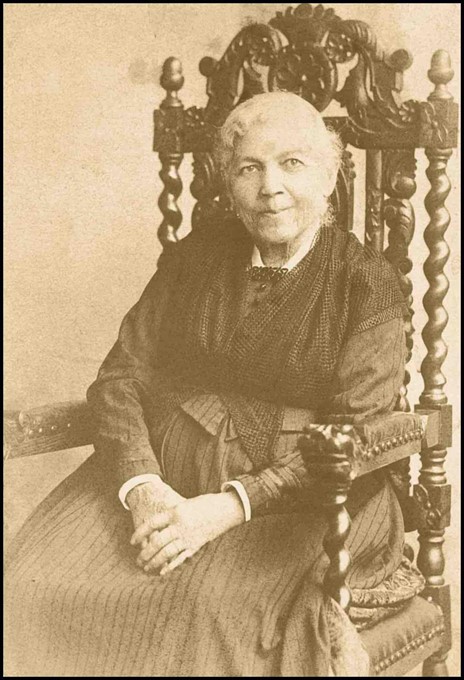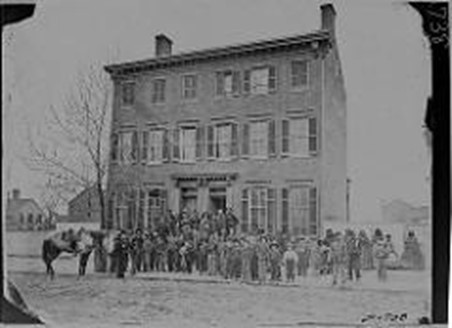Harriet Jacobs’s Next Chapter: Civil War Alexandria
ECW welcomes back guest author Paula Tarnapol Whitacre
In 1861, Harriet Jacobs published the book Incidents in the Life of a Slave Girl, an account of her experiences growing up enslaved in North Carolina and her harrowing escape to New York. Sales were disappointing, in part because the beginning of Civil War hostilities overshadowed the release. However, the book connected Jacobs with leading abolitionists and led to an unexpected opportunity for Jacobs, then in her mid-40s.
“Life Among the Contrabands”
In June 1862, William Lloyd Garrison, publisher of the Liberator, asked Jacobs to report on conditions of the hundreds of Black men, women, and children who were escaping slavery by coming into Washington. On September 5, 1862, The Liberator published her article “Life Among the Contrabands,” which she wrote in the form of a letter to Garrison.[1] (“Contraband” was the initial word used to describe people who escaped slavery by crossing Union lines based on the interpretation that they were “contraband property” of the Confederate enemy. The more human-centered term “freedpeople” replaced it.)[2] She described deplorable conditions of illness and abysmal shelter, but also of bravery and forbearance. She also commented on the valiant work of White and Black people who were on the scene trying to help.
The assignment took her across the Potomac River to Alexandria, which the Federal Army had occupied since May 1861, when Virginia seceded. Visiting a building used as a makeshift refugee shelter, she wrote, “This I found the most wretched of all places. Anyone who could find an apology for slavery should visit this place, and learn its curse. Here you see them from infancy up to a hundred years old. What but the love of freedom could bring these old people hither?”
She closed the article with a plea to readers: “Trust them [refugees], make them free, and give them the responsibility of caring for themselves.” As she wrote those words, she probably did not foresee that she would move to Alexandria less than six months later to do just that.

Assignment in Alexandria
Jacobs had brought donated clothes and other goods to distribute on her reporting trip. Her article helped stimulate relief efforts, including by the New York Yearly Meeting of Friends. This Quaker group, which had sent two members south on a fact-finding mission in late 1862, decided to provide Jacobs with donated clothes and other items and support her as a relief worker in Alexandria.[3]
The first known record in Jacobs’s own words about her assignment is dated March 18, 1863.[4] Acknowledging the destitution and illness, she wrote, “Many have found employment and are supporting themselves and their families. It would do your heart good to talk with some of these people.” Knowing the letter would be publicly shared, she did not share her emotions about entering her new situation. However, we do have impressions culled from the letters and diaries of Julia Wilbur, a Rochester, New York abolitionist who had moved to Alexandria the previous November. Wilbur was polite, but wary, and perhaps not initially very welcoming to the newcomer. In a letter back to Rochester, Wilbur wrote, “I think H. Jacobs is a very nice person & well calculated to give personal attention to those people.” But she also complained about having to share space with Jacobs to distribute clothing. “I have told Mrs. Jacobs that if we receive the N.Y. boxes, our room is not large enough to keep things separate,” Wilbur wrote. She also sounded miffed that Jacobs came with instructions to keep close tabs on the clothing “to prevent fraud or mistakes,” feeling that her own, more haphazard methods of distribution were being criticized.[5]
Jacobs became sick shortly after she arrived, not surprising given the respiratory, digestive, and other illnesses rampant in the city. By the time she recovered a few weeks later, as recorded by Wilbur, the two women began a productive and warm partnership.
Two incidents among many illustrate how Harriet Jacobs’s skills in advocacy and organizing grew during the more than two years she spent in Alexandria.

Fighting for Orphans
Jacobs arrived during one of the periodic outbreaks of smallpox that affected Alexandria. Freedpeople living in close quarters with limited access to health care were particularly hard hit. Military Governor Brig. Gen. John Slough, worried about contagion among Federal troops, ordered vaccination campaigns, but coverage was spotty. Quarantine houses could not accommodate the increasing number of patients. Slough and John Bigelow, a New York doctor appointed to supervise freedpeople’s health, decided to use Claremont, a confiscated estate south of the city, as a smallpox hospital for Blacks.
Bigelow also thought Claremont could conveniently solve another issue on his plate, which was what to do with orphans. If they were sent to Claremont, he proposed that “the same old women & nurses that take care of the sick” could take care of them.[6] When Jacobs and Wilbur learned of the plan to house healthy children with contagious smallpox patients, they were appalled.
They decided to object directly to Slough. For two women in the 1860s, especially a Black woman, this action challenged the societal expectation of women speaking out. “My friend,” Wilbur wrote in a letter, “this was really a great undertaking for us; we are in such a state of nervous excitement, that we were all of a trouble, & we had such a head ache, too!”[7] But they managed their nervousness. Moreover, Wilbur said, “Mrs. Jacobs spoke very handsomely to him, & when pleading for the children said she “I have been a slave myself.’” It is unlikely that Slough, an Ohioan with no particular sympathies for Black freedom seekers, had ever directly heard such words.
Slough agreed with their proposal to keep the children in a newly constructed freedpeople’s barracks and hire caregivers for them. In addition, Jacobs later wrote, “In many cases, mothers who have five or six of their own, without enough to feed and cover them, will readily receive these helpless little ones into their own poor hands.” She also appealed to Northern supporters to take care of orphaned refugee children.
The Jacobs School
Schools for Blacks, illegal under Virginia law, opened schools shortly after the Federal Army secured Alexandria. The schools were immensely popular for both children and adults, but charged tuition and/or were under White leadership. Jacobs wanted to establish a free school under Black leadership. As construction began in late 1863 under a board of trustees comprised of freedmen, Jacobs traveled north. She returned with donated funds, as well as her daughter Louisa and a friend, Virginia Lawton, to serve as teachers. In her absence, construction stalled, and several White male missionaries tried to insert themselves into the governance of the school. “A question arose whether the white teachers or the colored teachers should be superintendents,” she wrote, but in her view, “The freedmen had built the school-house for their children, and were Trustees of the school.”

The results of a meeting to decide the question thrilled her. Rather than acquiesce to White preferences, the Black leaders “born and bred into slavery” put the question to a vote and decided that Louisa Jacobs should take charge. “I wish you could have been at that meeting,” she wrote. “The fact of their giving preference to colored teachers as managers of the establishment seemed to us to indicate that even their brief possession of freedom had begun to inspire them with respect for their race.”[8]
Named in her honor, the Jacobs School opened with 78 “scholars” in January 1864. It operated for several years and then merged with other schools in the city.
Harriet Jacobs’s Subsequent Chapters
Harriet Jacobs remained in Alexandria until July 1865. She and Louisa tried to establish an orphanage in Savannah, but violence there became too menacing. She ran boarding houses in Cambridge, Massachusetts and Washington, DC, until well into her 70s. Money and health problems plagued her until her death on March 7, 1897. The well-known minister Francis Grimké eulogized, “She was always a positive quantity, easily recognizable, and always sure to be felt wherever her lot was cast.”[9] She is buried at Mount Auburn Cemetery in Cambridge.
Incidents in the Life of a Slave Girl, notwithstanding its disappointing sales in the 1860s and years in which it lay forgotten, is now considered one of the nation’s most significant first-person accounts of enslavement and self-emancipation.[10]
Paula Tarnapol Whitacre contributed a chapter to the book Clara Barton: Civil War Humanitarian(NMCWM Press, 2022). In 2017, she published a biography of abolitionist Julia Wilbur titled A Civil Life in an Uncivil Time: Julia Wilbur’s Struggle for Purpose (Potomac Books, 2017). She is currently researching a book that focuses on Alexandria, Virginia, during the Civil War and Reconstruction.
[1] “Life Among the Contrabands,” originally published on September 5, 1862, is reprinted in the Harriet Jacobs Family Papers, Volume 2, edited by Jean Fagan Yellin.
[2] For a discussion of this, see Kate Masur, “A rare phenomenon of philological vegetation: The word ‘contraband’ and the meanings of emancipation in the United States,” The Journal of American History, 93(3), March 2007, pp. 1050-1084.
[3] “Second report of a committee of representatives of New York Yearly Meeting of Friends upon the conditions and wants of the colored refugees.” Available at https://www.loc.gov/item/91899124/
[4] The March 18, 1863, letter to activist Lydia Maria Child (who also edited Incidents in the Life of Slave Girl) was published in the Liberator on April 10, 1863.
[5] Julia Wilbur to Anna C. Barnes, January 15, 1863. Barnes was treasurer of the Rochester Ladies’ Anti-Slavery Society, which was sponsoring Wilbur’s work in Alexandria. Available in the Rochester Ladies Anti-Slavery Society Papers, William C. Clements Library, University of Michigan.
[6] Quoted in Tim Dennee, “African-American Civilians and Soldiers Treated at Claremont Smallpox Hospital, Fairfax County, Virginia, 1862–1865.” Available at http://www.freedmenscemetery.org/resources/documents/claremont.pdf
[7] Julia Wilbur to Anna Barnes, March 10, 1863. Available in the Rochester Ladies Anti-Slavery Society Papers, William C. Clements Library, University of Michigan.
[8] Harriet Jacobs to Lydia Maria Child, March 26, 1864, in the Harriet Jacobs Papers, Volume 2.
[9] “Eulogy of Harriet Jacobs” in the Francis J. Grimké papers, reprinted in the Harriet Jacobs Papers, Volume 2.
[10] For more information on Harriet Jacobs’s rich life, see Jean Yellin, Harriet Jacobs: A Life. After many years of research in the 1970s and 1980s, Yellin connected Incidents in the Life of a Slave Girl, then believed to be fiction, with the real story of Harriet Jacobs. She explained how in the Introduction to the biography. Yellin passed away earlier this year.
Thanks for sharing these insights into Harriet Jacobs’ later life. I have the students in my English 11 class read an excerpt from her “Incidents in the Life of a Slave Girl” as part of our slavery unit, but I hadn’t read much about what she did in her later life. A very strong, persevering, determined, compassionate woman!